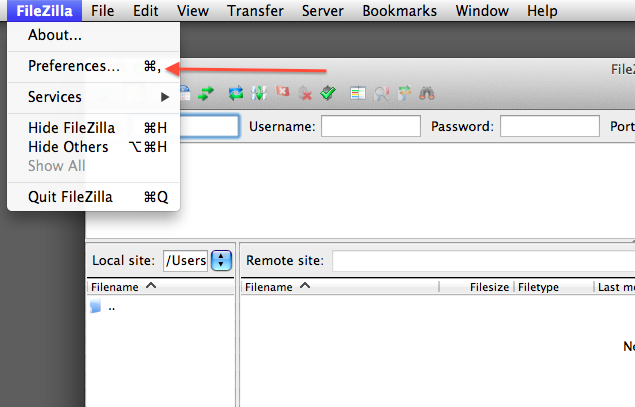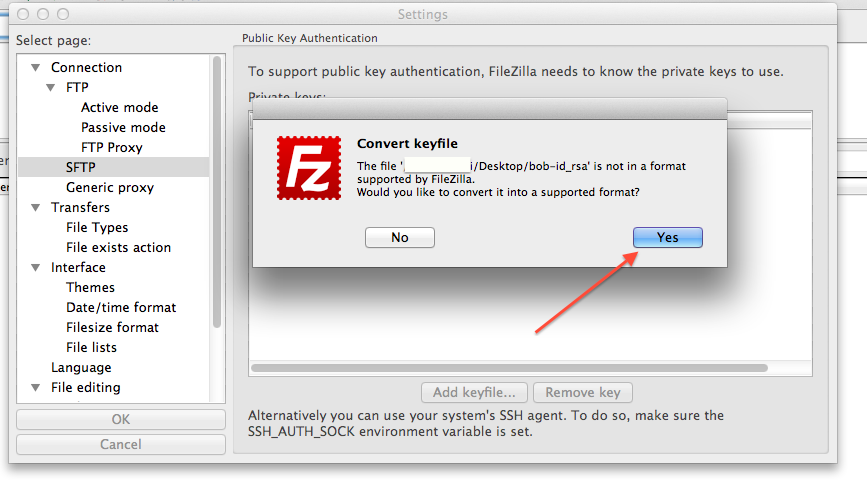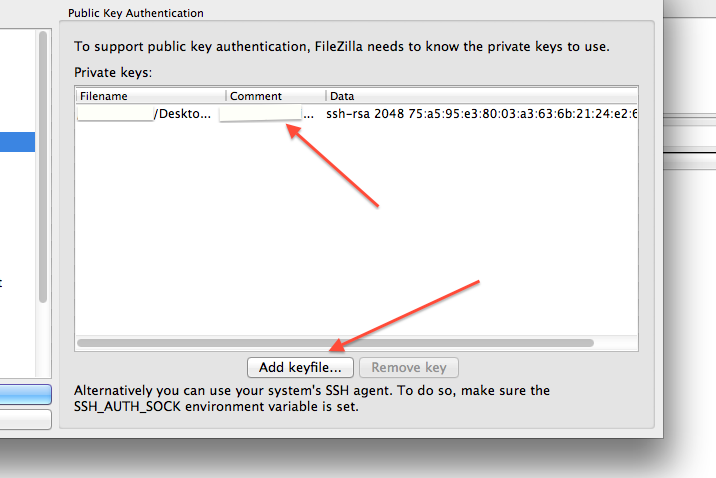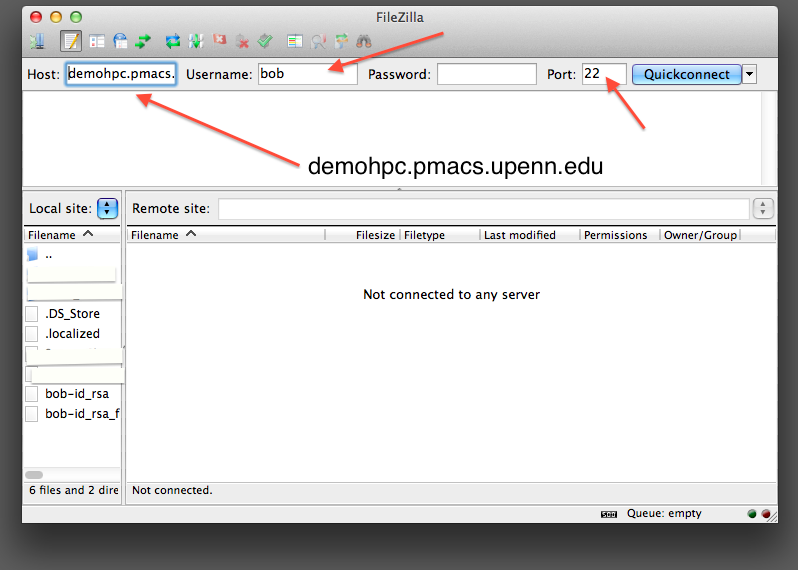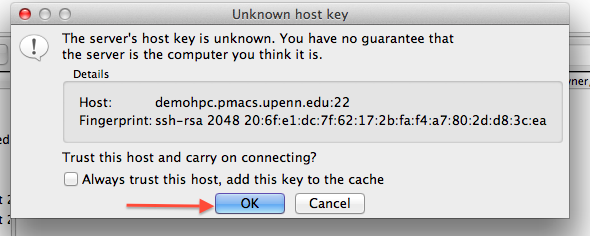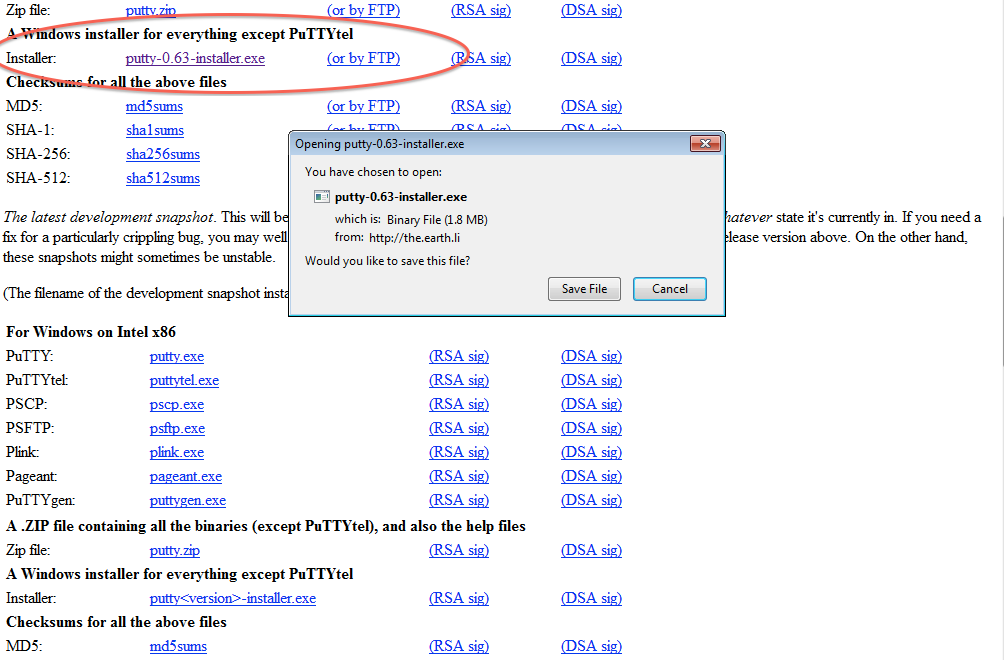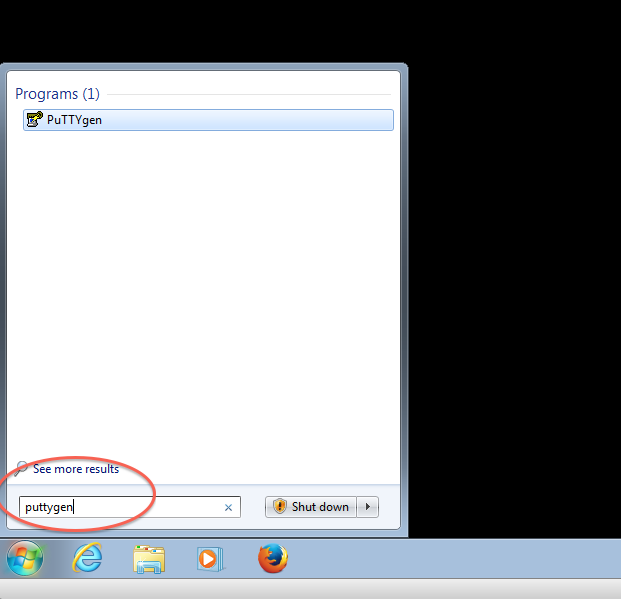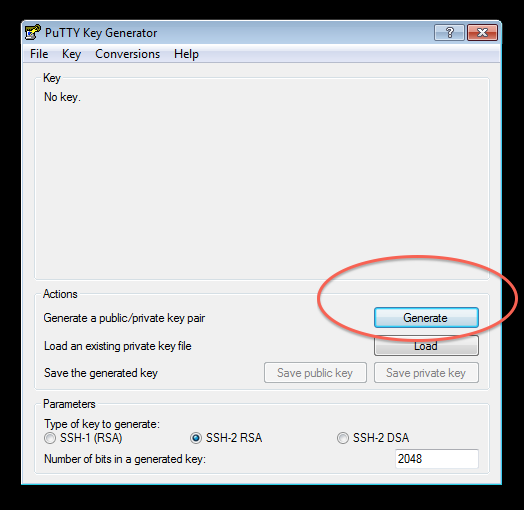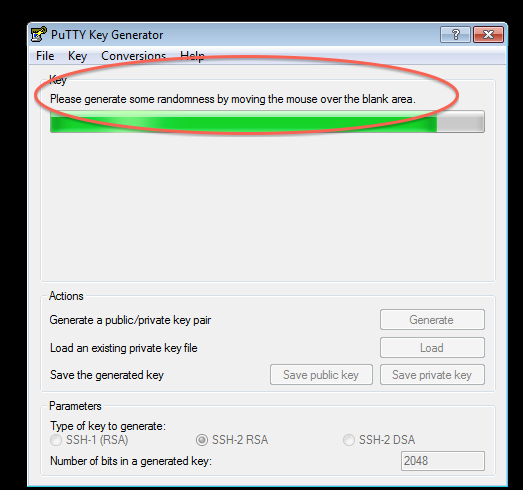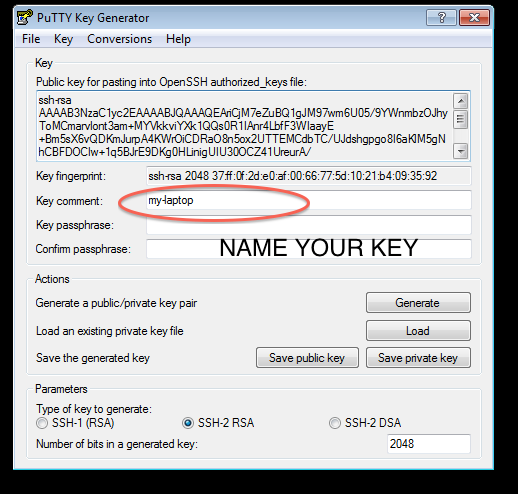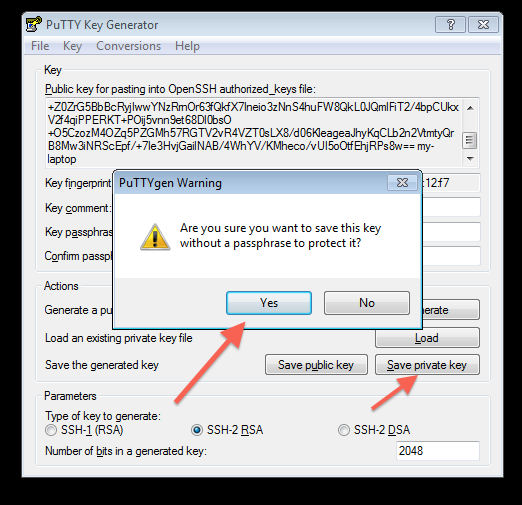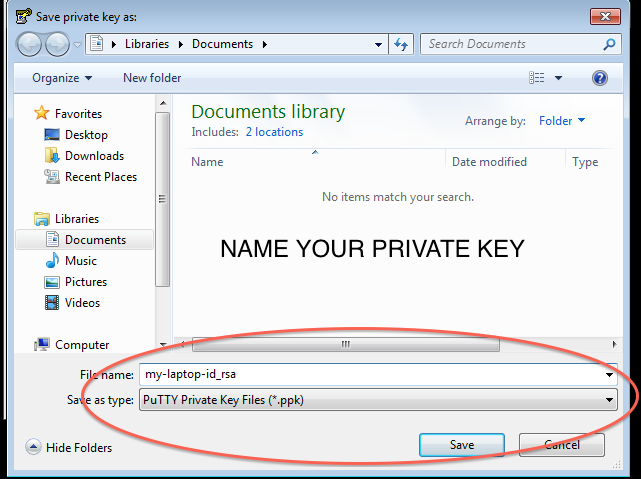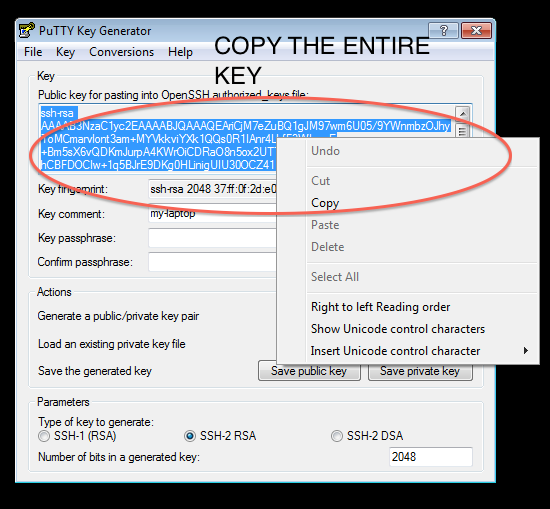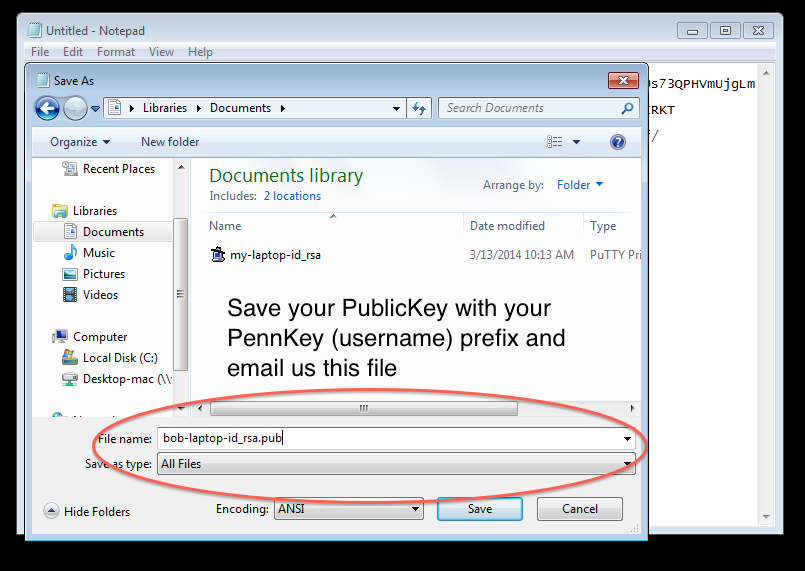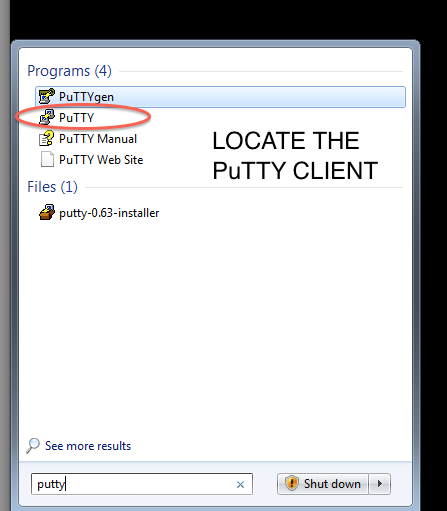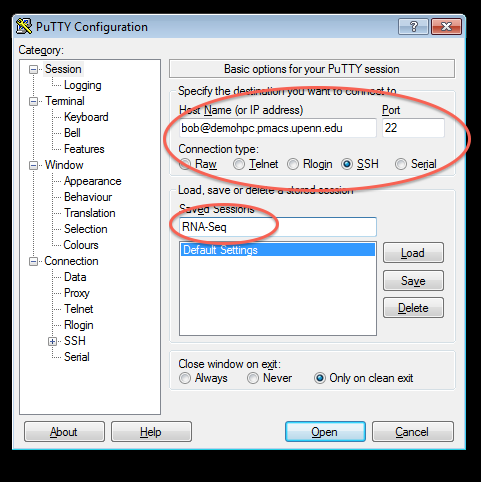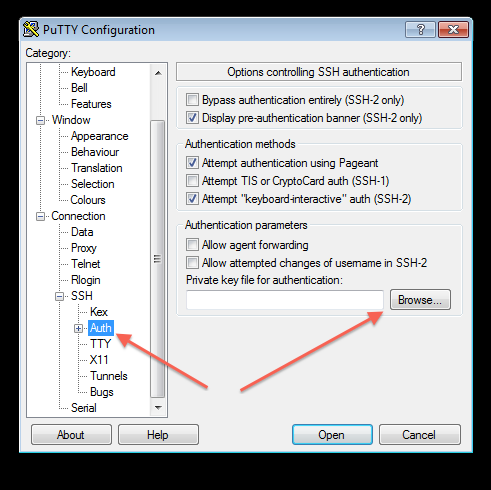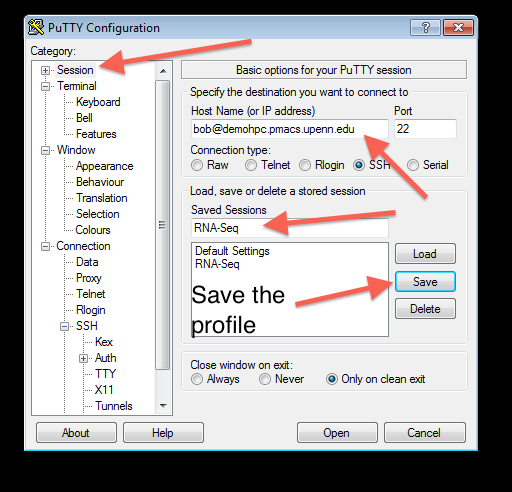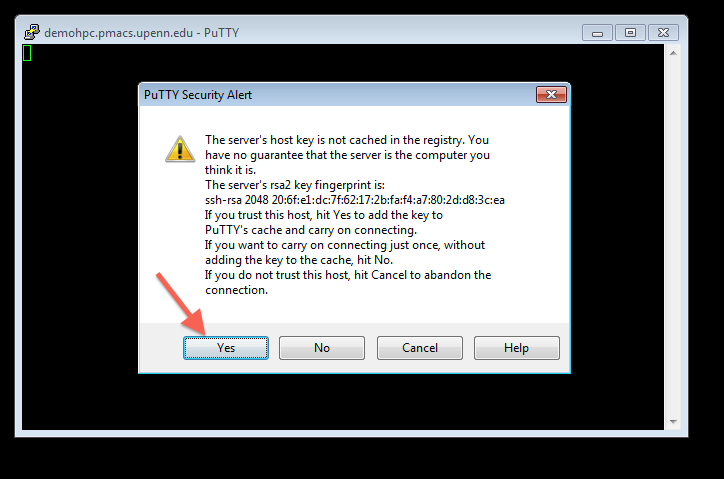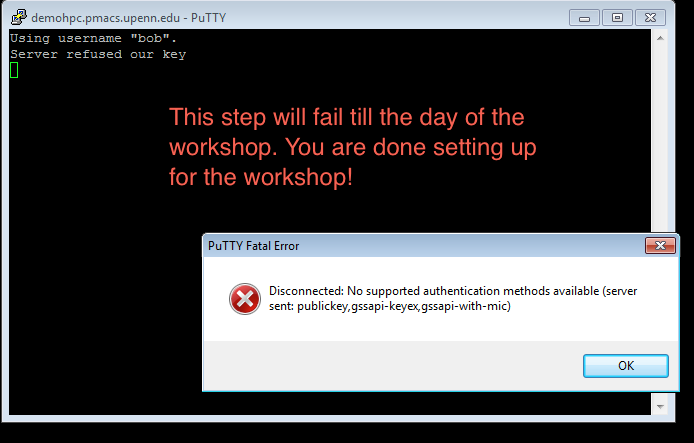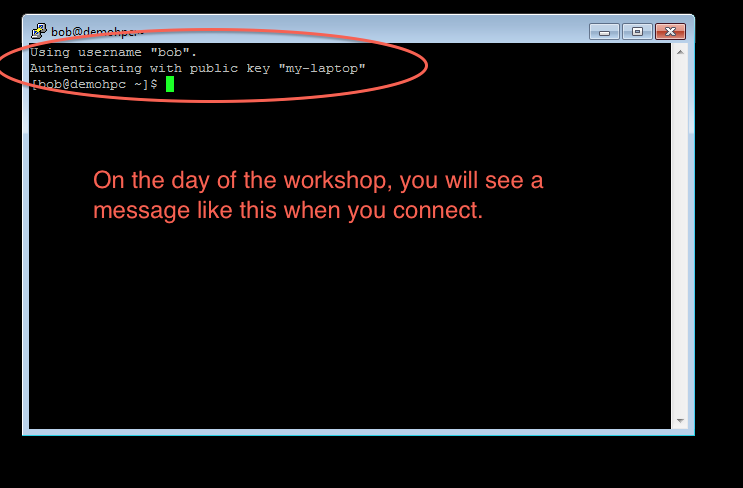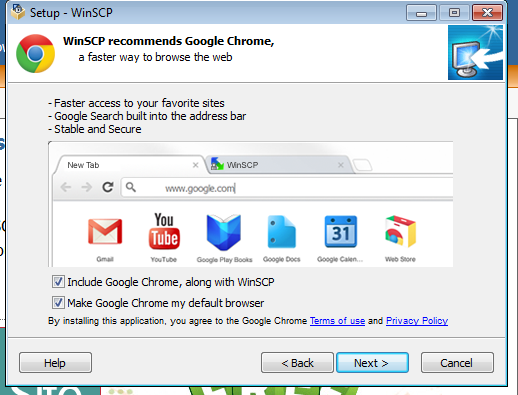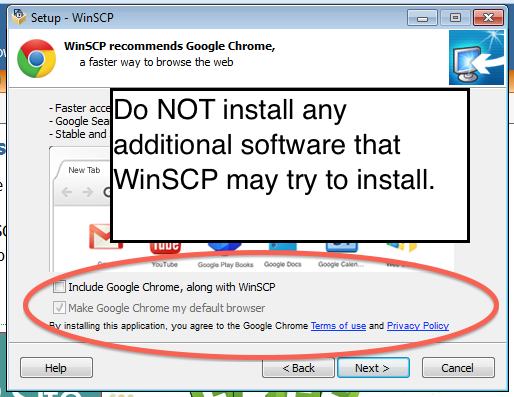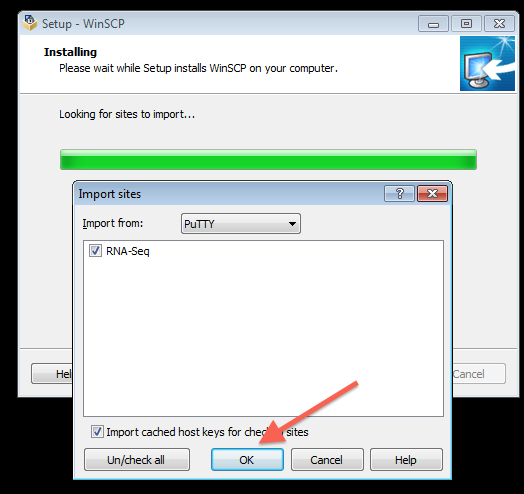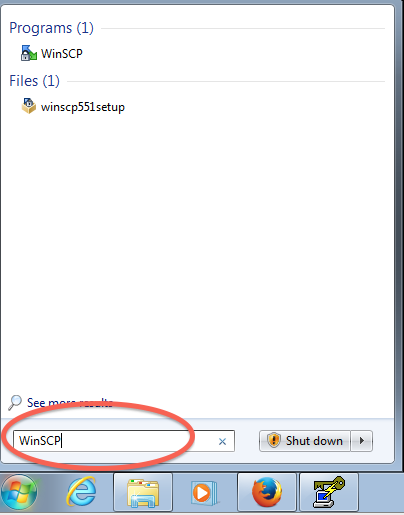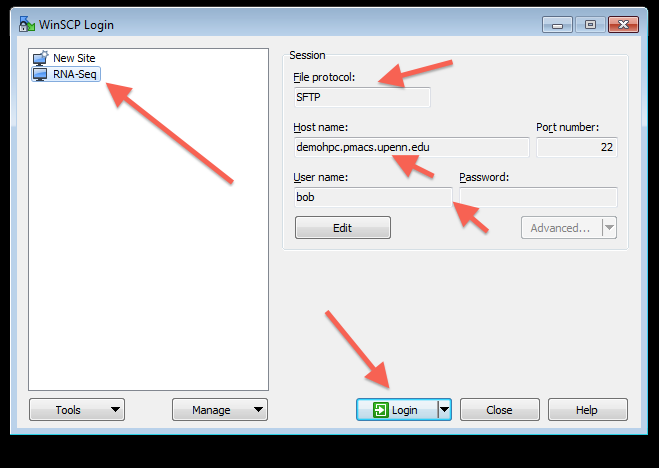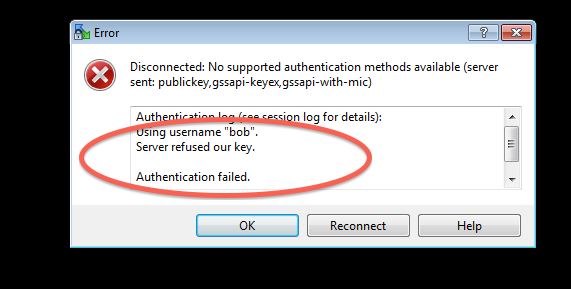Difference between revisions of "GCB 537:Main Page"
(Created page with "This page is intended to provide participants of the RNA-Seq workshop with the pre-workshop information. For detailed information about the PMACS HPC go to HPC:Main_Page|our...") |
|||
| Line 1: | Line 1: | ||
| − | This page is intended to provide | + | This page is intended to provide students enrolled in GCB537 with information about how to access the dedicated compute cluster for this course. For detailed information about the PMACS HPC go to [[HPC:Main_Page|our main page]] |
| − | |||
| − | |||
| − | == Important | + | == '''Important information''' == |
| − | |||
| − | + | === Setup === | |
| − | + | In the sections that follow, information is provided on how student laptops/desktops can be configured to access the compute environment dedicated for the course: GCB537. '''You may find references to a server called demohpc.pmacs.upenn.edu, please remember to replace this with gcb537.pmacs.upenn.edu'''. | |
| + | === The Environment === | ||
| + | The compute cluster environment dedicated to the GCB537 course closely resembles the PMACS HPC environment. Some of the basic job submission commands taught in this course may be used on the PMACS cluster. | ||
| + | However, some changes to the commands/scripts may be necessary before attempting to run these on the PMACS cluster. | ||
| − | + | The course environment is behind a firewall and students who wish to access this environment from off-campus/non-Penn networks must use the VPN. See below for VPN instructions. | |
| − | == Connecting to the | + | SSH is the only protocol allowed through the firewall to course's compute environment. File transfer to/from this environment is allowed only through SCP/SFTP. Students are expected to use client programs that support SSH (for terminal/command line access) and SCP/SFTP (for file transfer operations). SSH/SCP/SFTP connections to this environment is allowed only by means of PublicKey authentication and not password based authentication. Instructions to setup Public-Private keypairs is provided in the sections below. |
| − | Secure shell (ssh) is the only supported method of connecting to the | + | |
| + | ==== List Important Servers ==== | ||
| + | * <strong>gcb537.pmacs.upenn.edu</strong> : login/job submission server ; Do '''NOT''' run jobs on this server; Always use one of the compute nodes | ||
| + | |||
| + | * [https://juneau.med.upenn.edu/ <strong>VPN For Off-Campus Access</strong>] | ||
| + | |||
| + | ==== VPN (for off-campus access) ==== | ||
| + | All students enrolled in the GCB537 course can use this VPN to establish secure connections to the class cluster when trying to SSH from off-campus. This is a web based VPN that can be accessed [https://juneau.med.upenn.edu/ <strong>here</strong>]. Once a VPN tunnel has been setup, normal SSH connections to the cluster head node: consign.pmacs.upenn.edu can be established. | ||
| + | |||
| + | '''Note 1''' There may be other VPNs managed by PMACS/UPHS. Please ensure that while connecting to the class cluster, you are using this VPN only. | ||
| + | |||
| + | '''Note 2''' The VPN link above may present you with a self-signed certificate ("Untrusted connection") message. It is good practice to always verify that you are connecting to the right server. The SHA1 fingerprint for the certificate is: | ||
| + | <pre> F9:60:55:46:7E:B4:35:55:A7:2D:06:F7:D8:0D:94:E4:3F:7D:D2:A1 </pre> | ||
| + | |||
| + | '''Note 3''' The web-based VPN is known to work with browsers like Firefox, Internet Explorer (IE) and Safari. There are known issues with using Chrome. | ||
| + | |||
| + | |||
| + | == Connecting to the class cluster environment == | ||
| + | Secure shell (ssh) is the only supported method of connecting to the class cluster environment. The login machine name is gcb537.pmacs.upenn.edu. Below are instructions on how to create Public-Private keys on GNU/Linux, Mac OSX and Windows systems. | ||
'''Note:''' While there are several SSH clients available for all platforms. We only show instructions for and are able to support the usage of the following tools. | '''Note:''' While there are several SSH clients available for all platforms. We only show instructions for and are able to support the usage of the following tools. | ||
| Line 26: | Line 44: | ||
* File transfer (SCP/SFTP) via WinSCP | * File transfer (SCP/SFTP) via WinSCP | ||
| − | If you have a preference for a different ssh client or file transfer program, please ensure that you know how to configure it to use Public Key Authenticaion before the | + | If you have a preference for a different ssh client or file transfer program, please ensure that you know how to configure it to use Public Key Authenticaion before the start of the semester. |
=== Setup information for GNU/Linux and Mac OSX Users === | === Setup information for GNU/Linux and Mac OSX Users === | ||
| Line 33: | Line 51: | ||
* If don't have keys, open a terminal and run the ssh-keygen command and follow the on-screen instructions refer picture below. | * If don't have keys, open a terminal and run the ssh-keygen command and follow the on-screen instructions refer picture below. | ||
* If you do have keys, copy the id_rsa.pub key to your desktop as username-id_rsa.pub where username is your PennKey username | * If you do have keys, copy the id_rsa.pub key to your desktop as username-id_rsa.pub where username is your PennKey username | ||
| − | * Email this file as an attachment to [mailto:pmacshpc@med.upenn.edu pmacshpc@med.upenn.edu] (please don't paste the contents of the file in the email). | + | * Email this file as an attachment to [mailto:pmacshpc@med.upenn.edu pmacshpc@med.upenn.edu] (please don't paste the contents of the file in the email). Ensure that emails have your full name, PennKey and the subject line "Public keys for GCB537" |
* Configure FileZilla/Cyberduck to use the newly generated keys | * Configure FileZilla/Cyberduck to use the newly generated keys | ||
| − | * '''Do not''' delete either the Public or Private key till after the | + | * '''Do not''' delete either the Public or Private key till after the semester |
| + | ==== SSH key generation and testing connection to the class compute environment ==== | ||
| − | + | ''' Note 1: While following the instructions below, replace the server name demohpc.pmacs.upenn.edu with gcb537.pmacs.upenn.edu ''' | |
| + | ''' Note 2: Your username is not "bob"! '''' | ||
| Line 45: | Line 65: | ||
==== FileZilla setup for copying files from demo environment ==== | ==== FileZilla setup for copying files from demo environment ==== | ||
| + | |||
| + | |||
| + | ''' Note 1: While following the instructions below, replace the server name demohpc.pmacs.upenn.edu with gcb537.pmacs.upenn.edu ''' | ||
| + | ''' Note 2: Your username is not "bob"! '''' | ||
[[image:FileZilla0.png|center]] <br> | [[image:FileZilla0.png|center]] <br> | ||
| Line 66: | Line 90: | ||
* Import the PuTTY compatible keys and profile into WinSCP | * Import the PuTTY compatible keys and profile into WinSCP | ||
* Test the connection | * Test the connection | ||
| − | * Email only the Public key as an attachment to [mailto:pmacshpc@med.upenn.edu pmacshpc@med.upenn.edu] (please don't paste the contents of the file in the email). | + | * Email only the Public key as an attachment to [mailto:pmacshpc@med.upenn.edu pmacshpc@med.upenn.edu] (please don't paste the contents of the file in the email). Ensure that emails have your full name, PennKey and the subject line "Public keys for GCB537" |
* '''Do not''' delete either the Public or the Private key till after the workshop | * '''Do not''' delete either the Public or the Private key till after the workshop | ||
| Line 90: | Line 114: | ||
==== Step 3: Configure PuTTY to use the keys that were generated above ==== | ==== Step 3: Configure PuTTY to use the keys that were generated above ==== | ||
| + | |||
| + | ''' Note 1: While following the instructions below, replace the server name demohpc.pmacs.upenn.edu with gcb537.pmacs.upenn.edu ''' | ||
| + | ''' Note 2: Your username is not "bob"! '''' | ||
[[image:PuTTY1.png|center]] <br> | [[image:PuTTY1.png|center]] <br> | ||
| Line 102: | Line 129: | ||
==== Step 4: Install and configure WinSCP to use the PuTTY profile created above ==== | ==== Step 4: Install and configure WinSCP to use the PuTTY profile created above ==== | ||
| + | |||
| + | ''' Note 1: While following the instructions below, replace the server name demohpc.pmacs.upenn.edu with gcb537.pmacs.upenn.edu ''' | ||
| + | ''' Note 2: Your username is not "bob"! '''' | ||
| + | |||
[[image:WinSCP0.png|center]] <br> | [[image:WinSCP0.png|center]] <br> | ||
[[image:WinSCP1.png|center]] <br> | [[image:WinSCP1.png|center]] <br> | ||
Revision as of 21:56, 8 January 2015
This page is intended to provide students enrolled in GCB537 with information about how to access the dedicated compute cluster for this course. For detailed information about the PMACS HPC go to our main page
Contents
- 1 Important information
- 2 Connecting to the class cluster environment
- 2.1 Setup information for GNU/Linux and Mac OSX Users
- 2.2 Setup information for Windows Users
- 2.2.1 Step 1: Download and install the PuTTY full installer (if you don't already have it installed)
- 2.2.2 Step 2: Generate Keypair and save a copy of both the Public and Private keys
- 2.2.3 Step 3: Configure PuTTY to use the keys that were generated above
- 2.2.4 Step 4: Install and configure WinSCP to use the PuTTY profile created above
Important information
Setup
In the sections that follow, information is provided on how student laptops/desktops can be configured to access the compute environment dedicated for the course: GCB537. You may find references to a server called demohpc.pmacs.upenn.edu, please remember to replace this with gcb537.pmacs.upenn.edu.
The Environment
The compute cluster environment dedicated to the GCB537 course closely resembles the PMACS HPC environment. Some of the basic job submission commands taught in this course may be used on the PMACS cluster. However, some changes to the commands/scripts may be necessary before attempting to run these on the PMACS cluster.
The course environment is behind a firewall and students who wish to access this environment from off-campus/non-Penn networks must use the VPN. See below for VPN instructions.
SSH is the only protocol allowed through the firewall to course's compute environment. File transfer to/from this environment is allowed only through SCP/SFTP. Students are expected to use client programs that support SSH (for terminal/command line access) and SCP/SFTP (for file transfer operations). SSH/SCP/SFTP connections to this environment is allowed only by means of PublicKey authentication and not password based authentication. Instructions to setup Public-Private keypairs is provided in the sections below.
List Important Servers
- gcb537.pmacs.upenn.edu : login/job submission server ; Do NOT run jobs on this server; Always use one of the compute nodes
VPN (for off-campus access)
All students enrolled in the GCB537 course can use this VPN to establish secure connections to the class cluster when trying to SSH from off-campus. This is a web based VPN that can be accessed here. Once a VPN tunnel has been setup, normal SSH connections to the cluster head node: consign.pmacs.upenn.edu can be established.
Note 1 There may be other VPNs managed by PMACS/UPHS. Please ensure that while connecting to the class cluster, you are using this VPN only.
Note 2 The VPN link above may present you with a self-signed certificate ("Untrusted connection") message. It is good practice to always verify that you are connecting to the right server. The SHA1 fingerprint for the certificate is:
F9:60:55:46:7E:B4:35:55:A7:2D:06:F7:D8:0D:94:E4:3F:7D:D2:A1
Note 3 The web-based VPN is known to work with browsers like Firefox, Internet Explorer (IE) and Safari. There are known issues with using Chrome.
Connecting to the class cluster environment
Secure shell (ssh) is the only supported method of connecting to the class cluster environment. The login machine name is gcb537.pmacs.upenn.edu. Below are instructions on how to create Public-Private keys on GNU/Linux, Mac OSX and Windows systems.
Note: While there are several SSH clients available for all platforms. We only show instructions for and are able to support the usage of the following tools.
GNU/Linux or Mac OSX:
- ssh via built-in terminal emulator program
- File transfer via either command line (scp) or FileZilla
Windows:
- ssh via PuTTY
- File transfer (SCP/SFTP) via WinSCP
If you have a preference for a different ssh client or file transfer program, please ensure that you know how to configure it to use Public Key Authenticaion before the start of the semester.
Setup information for GNU/Linux and Mac OSX Users
Summary of tasks:
- Verify that you haven't already generated a Public-Priviate keypair (look inside the .ssh directory in your home area)
- If don't have keys, open a terminal and run the ssh-keygen command and follow the on-screen instructions refer picture below.
- If you do have keys, copy the id_rsa.pub key to your desktop as username-id_rsa.pub where username is your PennKey username
- Email this file as an attachment to pmacshpc@med.upenn.edu (please don't paste the contents of the file in the email). Ensure that emails have your full name, PennKey and the subject line "Public keys for GCB537"
- Configure FileZilla/Cyberduck to use the newly generated keys
- Do not delete either the Public or Private key till after the semester
SSH key generation and testing connection to the class compute environment
Note 1: While following the instructions below, replace the server name demohpc.pmacs.upenn.edu with gcb537.pmacs.upenn.edu Note 2: Your username is not "bob"! '
FileZilla setup for copying files from demo environment
Note 1: While following the instructions below, replace the server name demohpc.pmacs.upenn.edu with gcb537.pmacs.upenn.edu Note 2: Your username is not "bob"! '
Setup information for Windows Users
Summary of steps
- Verify that you haven't already generated a Public-Priviate keypair (if you haven't used keys before, its safe to assume you don't have a key pair already)
- If you haven't installed PuTTY (the full installer), you can download and install it from here
- Once installed, PuttyGen should be used to generate and save a PuTTy compatible Public-Private keypair
- PuTTY will be configured to use the generated keypair
- Install WinSCP for file transfer. WinSCP can be downloaded from here
- Import the PuTTY compatible keys and profile into WinSCP
- Test the connection
- Email only the Public key as an attachment to pmacshpc@med.upenn.edu (please don't paste the contents of the file in the email). Ensure that emails have your full name, PennKey and the subject line "Public keys for GCB537"
- Do not delete either the Public or the Private key till after the workshop
Step 1: Download and install the PuTTY full installer (if you don't already have it installed)
Step 2: Generate Keypair and save a copy of both the Public and Private keys
Step 3: Configure PuTTY to use the keys that were generated above
Note 1: While following the instructions below, replace the server name demohpc.pmacs.upenn.edu with gcb537.pmacs.upenn.edu Note 2: Your username is not "bob"! '
Step 4: Install and configure WinSCP to use the PuTTY profile created above
Note 1: While following the instructions below, replace the server name demohpc.pmacs.upenn.edu with gcb537.pmacs.upenn.edu Note 2: Your username is not "bob"! '



